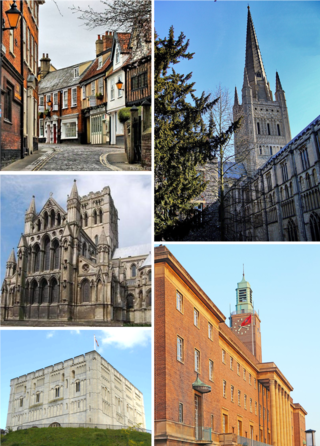Related Research Articles

Norfolk is a ceremonial and non-metropolitan county in East Anglia in England. It borders Lincolnshire to the north-west, Cambridgeshire to the west and south-west, and Suffolk to the south. Its northern and eastern boundaries are the North Sea, with The Wash to the north-west. The county town is the city of Norwich. With an area of 2,074 sq mi (5,370 km2) and a population of 859,400, Norfolk is a largely rural county with a population density of 401 per square mile. Of the county's population, 40% live in four major built up areas: Norwich (213,000), Great Yarmouth (63,000), King's Lynn (46,000) and Thetford (25,000).

East Anglia is an area in the East of England, often defined as including the counties of Norfolk, Suffolk and Cambridgeshire. The name derives from the Anglo-Saxon kingdom of the East Angles, a people whose name originated in Anglia, in what is now Northern Germany.

Sudbury is a market town in the south west of Suffolk, England, on the River Stour near the Essex border, 60 miles (97 km) north-east of London. At the 2011 census, it had a population of 13,063. It is the largest town in the Babergh local government district and part of the South Suffolk constituency.

Norwich is a cathedral city and district of Norfolk, England, of which it is the county town. Norwich is by the River Wensum, about 100 mi (160 km) north-east of London, 40 mi (64 km) north of Ipswich and 65 mi (105 km) east of Peterborough. As the seat of the See of Norwich, with one of the country's largest medieval cathedrals, it is the largest settlement and has the largest urban area in East Anglia.
William Wilkins was an English architect, classical scholar and archaeologist. He designed the National Gallery and University College London, and buildings for several Cambridge colleges.

The Bishop of Norwich is the ordinary of the Church of England Diocese of Norwich in the Province of Canterbury. The diocese covers most of the county of Norfolk and part of Suffolk. The bishop of Norwich is Graham Usher.
This article describes the history of Suffolk, the English county.

The Eastern Union Railway (EUR) was an English railway company, at first built from Colchester to Ipswich; it opened in 1846. It was proposed when the earlier Eastern Counties Railway failed to make its promised line from Colchester to Norwich. The businessman John Chevallier Cobbold and the engineer Peter Bruff were prominent in launching the company. The allied but nominally independent Ipswich and Bury Railway built a line onwards to Bury St Edmunds, also opening in 1846, and soon amalgamated with the EUR.

Sturmer is a village in the county of Essex, England, 2 miles (3 km) SE of Haverhill and close to the county border with Suffolk. Its name was originally "Stour Mere", from the River Stour and is explicitly mentioned in the Domesday Book of 1086. A Tudor illustration of the mere from the summer of 1571 exists in the National Archives. The mere still exists today to the east of the village. The village also gives its name to the Sturmer Pippin apple which was raised by Ezekiel Dillistone from 1831, and grown in the orchards of the village.

Norfolk County Cricket Club is one of twenty minor county cricket clubs within the domestic cricket structure of England and Wales. It represents the historic county of Norfolk.

The Theatre Royal, formerly the New Theatre, is a restored Regency theatre in Bury St. Edmunds, Suffolk, England. The building is one of eight Grade I listed theatres in the United Kingdom, and is the only working theatre operated under the auspices of the National Trust. It is considered to be one of the most perfect examples of Regency theatres in Britain.

Brandon is a town and civil parish in the English county of Suffolk. Brandon is located in the Breckland area of Suffolk, close to the adjoining county of Norfolk. It lies between the towns of Bury St Edmunds, Thetford, Mildenhall, Downham Market and the city of Ely. It lies next to Thetford Forest Park.

Norwich Arts Centre is a live music venue, theatre and art gallery located in St Benedict's Street in Norwich, Norfolk, England. It has a capacity of 300 for standing music concerts and 120 for seated events. In November 2014, it was named "Britain's Best Small Venue" by the NME.
The Colne Valley and Halstead Railway (CVHR) is a closed railway between Haverhill, Suffolk and Chappel and Wakes Colne, Essex, in England.

Stoke-by-Clare is a small village and civil parish in Suffolk located in the valley of the River Stour, about two miles west of Clare.
The National Cycle Route 13 is a cycling route that is part of the National Cycle Network in the United Kingdom. It connects Tower Bridge in London with Fakenham in Norwich.
The Norwich Company of Comedians was an acting company based in Norwich, East Anglia, during the 18th and 19th centuries. They used to perform on what was known as the Norwich Theatre Circuit, which consisted of an annual tour of six theatres.
The Stour Valley Railway is a partially closed railway line that ran between Shelford, near Cambridge and Marks Tey in Essex, England. The line opened in sections between 1849 and 1865. The route from Shelford to Sudbury closed on 6 March 1967 leaving only the section from Sudbury to Marks Tey, known as the Gainsborough Line, in operation.
Suffolk county cricket teams were the cricket teams that represented the historic county of Suffolk before the first official formation of Suffolk County Cricket Club in 1864.
John Brunton (1741–1822) was an English actor who became the manager of a circuit of theatres in and around Norfolk. He assiduously cultivated emerging talent in his company, which also produced actors amongst his children and grandchildren. He also used funds from his theatrical successes to fund philanthropy, including establishing the Norwich Theatrical Fund.